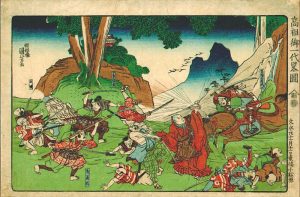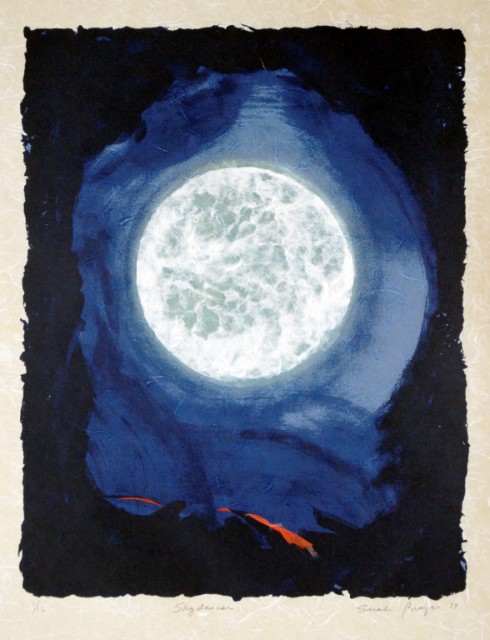
Silkscreen and chine-collé on washi with phosphorescent pigment, ed. 12.
Image Courtesy of the artist and the Tolman Collection of New York.
Enlightenment is like the moon reflected on the water.
The moon does not get wet, nor is the water broken.
Although its light is wide and great,
The moon is reflected even in a puddle an inch wide.
The whole moon and the entire sky
Are reflected in one dewdrop on the grass.
Dogen, the 13th century founder of Japanese Soto Zen Buddhism, beautifully expresses in this verse the Buddhist concept that an understanding of the true nature of life and reality is like a light that grows within us to illuminate, reflect, and transform all around. He compares the awakening of spiritual awareness—or enlightenment—to the moon radiating its light infinitely, glowing not only in the vastness of the sky but also filling the tiniest dewdrop. American artist Sarah Brayer has been conveying a similar spiritual luminescence in her body of poured paper and printed works depicting the Moon, the Sun, and other cosmic phenomena, made all the more captivating by the use of phosphorescent pigments that infuse the image with light that can recharge indefinitely and illuminate the works even in darkness.
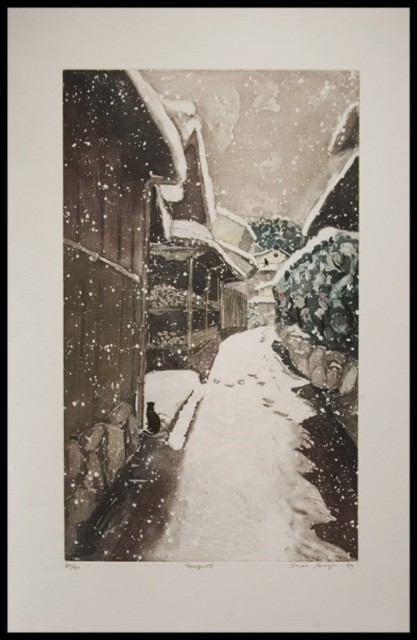
Image courtesy of the artist and Verne Gallery
Brayer’s luminescent works have been born out of a decades-long exploration of printmaking and papermaking in the West and in Japan. Originally from Rochester, New York, Brayer first studied printmaking techniques in London in 1978, then went to Japan in her twenties to learn more about Japanese art, piqued by an interest in raku-style ceramics that are used in the tea ceremony. However, she soon fell in love with Japanese culture and landscapes and began creating prints depicting her views of Japan, using a variety of techniques. Her earlier lithographs, aquatints, and woodblock prints are largely representational, capturing urban and rural scenes with a delicacy and restraint that reflect a deep understanding of Japanese spirituality. In her 1999 aquatint Footprints, she presents a snowy street scene with such subtlety that we can almost hear the silence of the snow falling on the Kyoto rooftops. Her rendering of falling snow echoes the works of earlier Japanese artists such as Ando Hiroshige (1797–1858) and Kawase Hasui (1883–1957), whose lyrical prints depicting well-traveled roads, temples, and mountains not only portray Japan’s physical landscapes but also convey a deep sense of mood, atmosphere, and emotion.
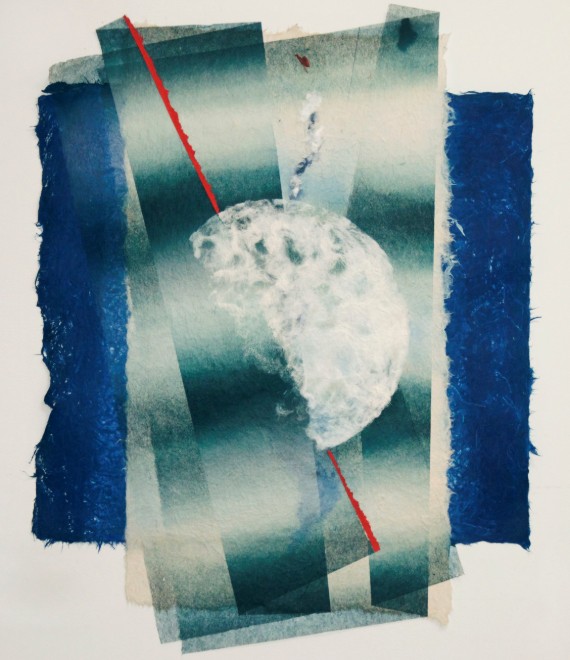
collage, 28×21 inches. Image courtesy of the artist and Tolman Collection of New York
While back in the US in 1986, Brayer was visiting the the Dieu Donne paper studio in New York and discovered poured paper, a painterly technique that allows the artist to create images by pouring paper pulp onto a paper frame, guiding the fibers into patterns and forms. This encounter inspired her to study traditional Japanese papermaking techniques (Jap: washi) at Imadate in Echizen (the oldest and most developed center of Japanese washi production) and apply them to her own style of image-making. Since 1986 she has been the only Western artist to continuously work there. In 2013, she was awarded the Bunkacho Chokan Hyosho prize by the Japanese government for enriching the cultural legacy of Echizen papermaking.
However, Brayer is not merely preserving traditional Japanese papermaking techniques in her works. Her innovative art blends ancient Japanese washi-making techniques and traditional Asian pigments, such as a rich indigo blue, with paper pouring, printing techniques, and pigments from the West. For Brayer, the experience of working with paper has been a profoundly spiritual one. “The paper medium is fluid and full of challenges,” she explains. “My task is to find new ways of expression in an age-old tradition. Many of my paperworks are well-choreographed in my mind before I begin, yet when the washi fibers hit the screen and begin to swirl, I am transported into a meditative state where assumptions are suspended and improvisation begins . . . that is very liberating!”
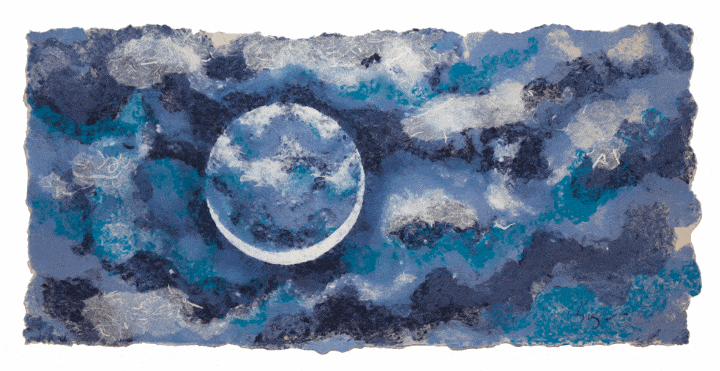
Image courtesy of the artist
The result is a unique art form that not only allows her artistry and spirituality to shine, but also literally illuminates elements of the artworks. One peice, Misty Blue Moon, is an exquisitely layered paperwork typical of her Luminosity series, which blends poured paper fibers with photo-luminescent pigments. At the center, a white sphere formed of white paper fibers appears to be thinly veiled by a sea of clouds floating in the dark night sky. Though at first we perceive a full moon through these clouds, it is the slender lunar crescent that is being highlighted in this work; the rest of the sphere is a mere ghost. Since the crescent element of the work was formed by adding phosphorescent pigments to the paper pulp, it is charged by the surrounding light. When the light is extinguished, the crescent is illuminated.
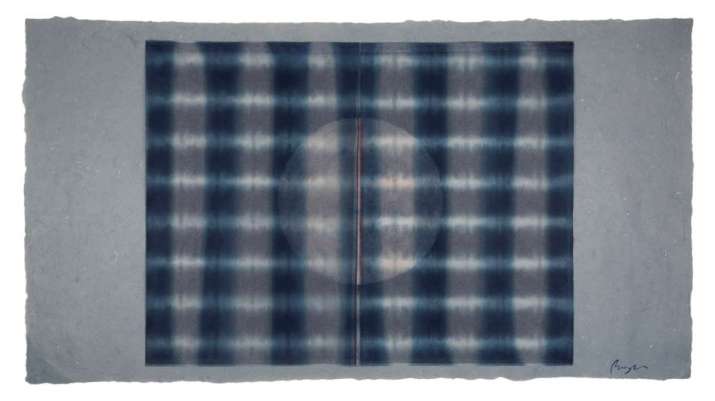
In another work in this series, Layered Moonlight, the Moon is barely perceivable in “daylight” behind what appears to be striped indigo-blue dyed cloth—the traditional fabric of Japan’s rural populations. The “cloth” is actually two layers of a thin mulberry paper called Tengujo, dyed in gradated colors and arranged to mimic the noren curtains that hang in the doorways of shops. However, when the lights are turned off—and night is emulated—the moon brightens, emerging from behind the curtain to become the focus of our attention. To Brayer, these works evoke the Buddhist principle that light is the highest vibrational energy and that inner light—the Buddha-nature—is what remains if all obstructions are removed. “In the Luminosity series,” she explains, “this inner light is inherent in the art itself. By viewing the work in shifting light conditions, one becomes aware of the outer transitory nature of daylight and inner unchanging light source within. By being in the dark, we become more aware of the inner light glowing within.”
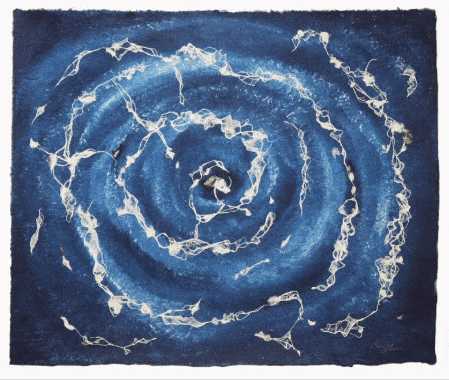
with phosphorescent pigment, gold leaf, 38×45 inches.
Image courtesy of the artist
Brayer’s exploration of inner light in her works on (and in) paper have added an exciting new dimension to printmaking and washi papermaking. As an artist, she has achieved the seemingly impossible—illuminating core details of her works so that they can be seen in the dark. By doing so, she invites the viewer to contemplate the light not only within the print but also within ourselves. Her work reminds us that we too can shine more brightly, reflecting like Dogen’s moon in the dewdrops and puddles.
See more
Sarah Brayer
Sarah Brayer art at the Verne Collection of Japanese Prints and Paintings
Sarah Brayer Art at the Tolman Collection, New York






